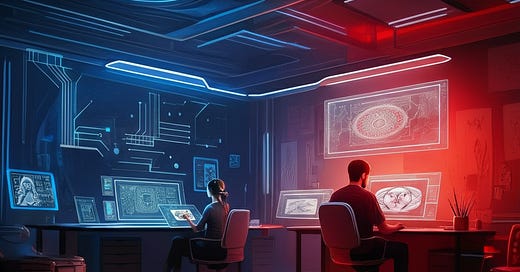Is AI Replacing Creative Design Solutions? Insights from the Latest Study
The rise of Artificial Intelligence (AI) has sparked countless debates across industries, and the creative field is no exception. With AI tools now capable of generating logos, redesigning websites, and producing digital artwork in seconds, it’s hard not to wonder—are creative design solutions in danger of being replaced by machines? For design professionals, creative agencies, and tech enthusiasts alike, this question is pressing.
This article explores the findings of the latest study on AI’s role in the creative field. We’ll break down the advantages and limitations of AI-driven graphic design solutions, what this means for creative design services, and how professionals can adapt to thrive in an AI-enhanced future.
Understanding AI in Creative Design Solutions
AI tools have revolutionized the creative industry by enhancing efficiency and expanding what’s possible. Programs like Adobe Sensei, Canva’s AI design features, and generative AI such as DALL-E have shown how automation can assist with tasks like editing, prototyping, and content creation.
But does this mean AI will replace the need for skilled designers? Not quite.
AI excels at automating repetitive tasks in graphic design solutions—resizing images, applying templates, or color correcting photos. However, when it comes to the nuanced, human-led process of turning emotions, ideas, and cultural storytelling into compelling visuals, AI still falls short. It’s these layers of complexity that make creative design services invaluable.
Key AI Capabilities in the Creative Space:
Efficiency in Task Automation: AI saves time by performing high-volume tasks like generating multiple ad variations for campaigns.
Style Suggestion and Consistency: Machine learning algorithms analyze branding to suggest designs that align with specific color schemes, fonts, and tones.
Expanding Accessibility: Small businesses with limited budgets can access basic design tools to create graphics without hiring professionals.
Where AI Falls Short:
While AI might automate processes, it does not replace creativity or emotional intelligence. Human designers think contextually, solve problems with originality, and adapt their work to the evolving needs of audiences—qualities machines cannot yet replicate.
Are Designers at Risk of Being Replaced?
The short answer is no. AI isn’t replacing designers; rather, it’s transforming the way design solutions are delivered. A study conducted by [Example Organization] highlights that 78% of design professionals believe AI tools enhance their workflow rather than threaten their roles.
Still, the industry is witnessing a shift. Entry-level and repetitive roles—like resizing ads or creating simple assets for marketing—may well diminish as AI takes on these tasks. However, opportunities for designers who specialize in complex, conceptual work are growing.
How Humans and Machines Complement Each Other:
Human Creativity + Machine Speed:
Designers can leverage AI tools to automate mundane tasks, allowing them to focus on high-value areas such as storytelling, strategy, and out-of-the-box ideation.
Data-Driven Design Insights:
AI analyzes audience behavior in real-time, providing insights that guide professional designers in creating impactful creative design solutions.
Room for Experimentation:
With AI workflows saving time, designers have more freedom to experiment, iterate, and innovate.
The Role of Agencies in an AI-Powered Era
Creative agencies, tasked with offering comprehensive design services, must evolve to meet new expectations. By integrating AI into their processes, these agencies can build hybrid workflows that balance human artistry with computational power.
How Agencies Can Adapt:
Upskill Teams: Provide training on the latest AI-powered software so teams can work seamlessly with these tools.
Focus on Strategy: Highlight services that AI cannot replicate, like brand building, strategic campaigns, and creative problem-solving.
Leverage AI for Insights: Agencies can use algorithm-driven analytics to advise clients on design strategies that will resonate most with their target audience.
This approach not only future-proofs agencies but also ensures clients receive unparalleled value from creative design services.
Building a Future-Proof Design Career
The rise of AI underscores the importance of adaptability in the design field. By keeping an open mindset and proactively learning how to integrate AI into existing workflows, designers can make themselves indispensable.
Tips for Designers:
Master AI Tools:
Learn to work with platforms like Adobe Sensei, MidJourney, or Runway AI to stay ahead of the curve.
Develop a Niche:
Specialize in areas that require high levels of creativity, such as conceptual art, storytelling, or branding.
Focus on Emotional Intelligence:
The intersection of culture, emotion, and visuals is where human designers shine. Keep honing soft skills like empathy and interpersonal communication.
Collaborate with AI:
Treat AI as a tool—not a competitor. Using AI effectively can increase the efficiency and quality of your work.
Creative Design Services in the Age of AI
The ongoing conversation isn’t simply about AI versus human designers. It's about how the two can co-exist, each amplifying the other’s strengths. Businesses should view AI tools as a way to expand their creative potential, not as a replacement for authentic design expertise.
For professionals in design, the challenge lies in staying curious, continuously learning, and using technology to elevate their craft. AI may take over repetitive tasks, but the soul of creativity—the ability to make people feel something significant—is uniquely human.
How AI Enriches, Not Replaces, Creative Design
The bottom line? AI is not rendering creative design solutions obsolete. Instead, it is a catalyst for innovation, pushing the boundaries of what’s possible in the field.
For design professionals, creative agencies, and tech enthusiasts, the future is bright. By leveraging AI smartly, we can make design more impactful, efficient, and accessible.
To explore new tools and ideas for transforming your design process, sign up for our newsletter or check out our expert guides. Stay creative—because the future of design is a collective effort between human thinking and machine learning.




